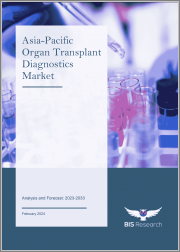
|
시장보고서
상품코드
1439029
아시아태평양의 장기 이식 진단 시장 : 분석 및 예측(2023-2033년)Asia-Pacific Organ Transplant Diagnostics Market: Analysis and Forecast, 2023-2033 |
||||||
| 주요 시장 통계 | |
|---|---|
| 예측 기간 | 2023-2033년 |
| 2023년 평가액 | 12억 5,000만 달러 |
| 2033년 전망 | 34억 5,000만 달러 |
| CAGR | 10.73% |
아시아태평양의 장기 이식 진단 시장 규모는 2023년 12억 5,000만 달러에 달할 것으로 예상됩니다.
이 시장은 2033년에는 34억 5,000만 달러에 달할 것으로 예상되며, 예측 기간인 2023-2033년 동안 10.73%의 CAGR을 기록할 것으로 예상됩니다. 장기 부전으로 이어지는 만성 질환의 증가, 이식 진단의 사용 증가, 줄기세포 치료의 채택 확대, 백혈병 환자 증가로 인한 이식 진단 검사에 대한 수요 증가, 이식 진단 분야의 분자 및 유전체 기술 발전에 따른 이점, 상환 제도를 포함한 유리한 규제 환경 등 여러 가지 중요한 요인이 이 산업의 성장을 주도하고 있습니다.
아시아태평양의 장기 이식 진단 시장은 다양한 요인에 힘입어 높은 성장세를 보이고 있습니다. 여기에는 장기 부전으로 이어지는 만성 질환의 유병률 증가, 이식 진단의 사용 확대, 이 지역의 줄기세포 치료 수용성 확대 등이 포함됩니다. 또한, 백혈병과 같은 질병의 유병률 증가는 이식 진단 검사에 대한 수요를 촉진하고 있습니다. 이 분야는 또한 진단 능력을 향상시키는 분자 및 유전체 기술의 발전으로 인해 혜택을 받고 있습니다. 또한, 유리한 규제 조건은 시장 성장을 더욱 촉진하고 있으며, APAC의 장기 이식 진단 시장은 장기 이식에 대한 효과적인 진단 솔루션에 대한 수요 증가에 따라 눈에 띄게 확대될 것으로 예상됩니다.
이 보고서는 아시아태평양의 장기 이식 진단 시장에 대해 조사했으며, 시장 개요와 함께 국가별 동향, 시장 진입 기업 개요 등을 제공합니다.
목차
주요 요약
제1장 시장 범위
제2장 조사 방법
제3장 장기 이식 진단 시장 : 개요
- 현재 시장 시나리오
- 시장 발자국
- COVID-19에 의한 시장에 대한 영향
제4장 장기 이식 진단 시장 : 업계 분석
- 개요
- 아시아태평양의 법적 요건과 체계
- 중국
- 일본
- 상환 시나리오
- 특허 분석
제5장 장기 이식 진단 시장 : 시장 역학
- 영향 분석
- 시장 촉진요인
- 시장 억제요인
- 시장 기회
제6장 지역
- 아시아태평양
- 아시아태평양의 장기 이식 검사 건수, 이식 유형별
- 시장 규모와 예측
제7장 기업 개요
ksm 24.03.11The Asia-Pacific Organ Transplant Diagnostics Market Expected to Reach $3.45 Billion by 2033
Introduction to Asia-Pacific Organ Transplant Diagnostics Market
| KEY MARKET STATISTICS | |
|---|---|
| Forecast Period | 2023 - 2033 |
| 2023 Evaluation | $1.25 Billion |
| 2033 Forecast | $3.45 Billion |
| CAGR | 10.73% |
In 2023, the Asia-Pacific organ transplant diagnostics market was valued at $1.25 billion and is expected to reach $3.45 billion by 2033, with a CAGR of 10.73% during the forecast period 2023-2033. Numerous pivotal factors are driving growth in this industry, comprising a rise in chronic diseases leading to organ failure, increased utilization of transplant diagnostics, growing adoption of stem cell therapy, heightened demand for transplant diagnostic tests due to an uptick in leukemia cases, advantages stemming from advancements in molecular and genomic technologies in the transplant diagnostics realm, and the presence of favorable regulatory environments, including reimbursement schemes.
Market Introduction
The Asia-Pacific (APAC) organ transplant diagnostics market is experiencing significant growth, propelled by various factors. This includes the escalating incidence of chronic diseases leading to organ failure, the expanding utilization of transplant diagnostics, and a rising acceptance of stem cell therapy in the region. Additionally, the increasing prevalence of conditions like leukemia is driving demand for transplant diagnostic tests. The sector also benefits from advancements in molecular and genomic technologies, enhancing diagnostic capabilities. Furthermore, favorable regulatory conditions, such as reimbursement schemes, further stimulate market growth. With these dynamics at play, the APAC organ transplant diagnostics market is poised for notable expansion, catering to the growing demand for effective diagnostic solutions in organ transplantation procedures across the region.
Market Segmentation:
Segmentation 1: by Country
- China
- Japan
- India
- Australia
- South Korea
- Singapore
- Rest-of-Asia-Pacific
How can this report add value to an organization?
Growth/Marketing Strategy: The APAC organ transplant diagnostics market has witnessed major development by key players operating in the market, such as product launches, business expansions, partnerships, collaborations, mergers and acquisitions, funding activities, and regulatory and legal approvals. The favored strategy for the companies has been synergistic activities such as partnerships, collaborations, expansions, and funding activities.
Competitive Strategy: The key players in the APAC organ transplant diagnostics market analyzed and profiled in the study involve established and emerging players that offer different products and services for organ transplant diagnostics. Moreover, a detailed competitive benchmarking of the players operating in the APAC organ transplant diagnostics market has been done to help the reader understand the ways in which players stack against each other, presenting a clear market landscape. Moreover, comprehensive competitive strategies such as partnerships, agreements, collaborations, and mergers and acquisitions will help the reader understand the untapped revenue pockets in the market.
Table of Contents
Executive Summary
1 Market Scope
- 1.1 Key Questions Answered in the Report:
2 Research Methodology
- 2.1 Organ Transplant Diagnostics Market: Research Methodology
- 2.2 Data Sources
- 2.2.1 Primary Data Sources
- 2.2.2 Secondary Data Sources
- 2.3 Market Estimation Model
- 2.4 Criteria for Company Profiling
3 Organ Transplant Diagnostics Market: Overview
- 3.1 Current Market Scenario
- 3.1.1 For Researchers
- 3.1.2 For Diagnostics
- 3.2 Market Footprint
- 3.3 COVID-19 Impact on Market
- 3.3.1 Impact on Operations
- 3.3.2 COVID-19 Impact: Current Scenario of Market
- 3.3.3 Pre- and Post-COVID-19 Impact Assessment
- 3.3.3.1 Pre-COVID-19 Phase
- 3.3.3.2 Post-COVID-19 Phase
4 Organ Transplant Diagnostics Market: Industry Analysis
- 4.1 Overview
- 4.2 Legal Requirements and Framework in Asia-Pacific
- 4.2.1 China
- 4.2.2 Japan
- 4.3 Reimbursement Scenario
- 4.4 Patent Analysis
- 4.4.1 Patent Filing Trend (by Country)
- 4.4.2 Patent Filing Trend (by Year)
5 Organ Transplant Diagnostics Market: Market Dynamics
- 5.1 Impact Analysis
- 5.2 Market Drivers
- 5.2.1 Rise in Incidence of Chronic Diseases Leading to Organ Failure Increases the Use of Transplant Diagnostics
- 5.2.2 Increase in Adoption of Stem Cell Therapy and Incidences of Leukemia Leading to an Upsurge in Demand for Transplant Diagnostics Tests
- 5.2.3 Presence of Favorable Regulatory Scenarios including Reimbursement Schemes for Some Organ Transplant Diagnostics
- 5.2.4 Advantages of Developing Advanced Molecular and Genomic Technologies in Transplant Diagnostics Tests
- 5.3 Market Restraints
- 5.3.1 Increased Gap in Organ Donation and Organ Transplant Demand Hinders the Growth of Organ Transplant Diagnostics Market
- 5.3.2 High Cost of Investment for Transplant Diagnostics Tests Acts as a Barrier to Growth of the Market
- 5.4 Market Opportunities
- 5.4.1 Development of Non-Invasive Techniques for Monitoring Transplant Recipients using NGS
- 5.4.2 Advancements in Human Leukocyte Antigen (HLA) Typing Tests for Organ Transplant
6 Region
- 6.1 Asia-Pacific
- 6.1.1 Asia-Pacific Organ Transplant Test Volume, by Transplant Type
- 6.1.2 Market Sizing and Forecast
- 6.1.2.1 Asia-Pacific Organ Transplant Diagnostics Market (by Country)
- 6.1.2.1.1 China
- 6.1.2.1.2 India
- 6.1.2.1.3 South Korea
- 6.1.2.1.4 Japan
- 6.1.2.1.5 Australia
- 6.1.2.1.6 Singapore
- 6.1.2.1.7 Rest-of-Asia-Pacific
- 6.1.2.1 Asia-Pacific Organ Transplant Diagnostics Market (by Country)
7 Company Profiles
- 7.1 Overview
- 7.2 Manufacturers



















